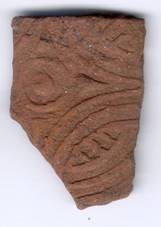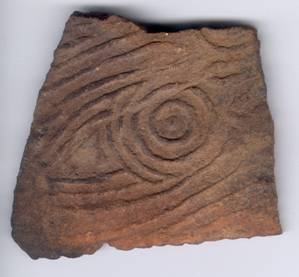|
We are conducting an archeological excavation at a significant prehistoric Native American village site located in Georgia in the southeastern United States (see www.bartowdig.com). Ceramic sherds are one of the most prolific artifact types at the site. Many of these are decorated on the exterior surface with designs termed “complicated stamped”. This intricate pottery was produced by people of the Swift Creek culture, roughly dating from 100 B.C – 800 A.D. Complicated stamped designs are generally composed of curvilinear geometric motifs, such as concentric and nested circles, figure eights, connected diamonds, spirals, and numerous other combinations. Prehistorically, these designs were carved into wooden paddles, which were then used to stamp the exterior of ceramic vessels. Based on studies of individual sherd designs, as well as imperfections in the designs, archeologists believe that each design was exclusive to a single paddle, similar to the individual nature of fingerprints. Furthermore, archeologists have found the same design at sites hundreds of kilometers apart, indicating widespread trade and interaction networks. Based on the current archeological database of these complicated stamped designs, it is also believed that there are hundreds, if not thousands, of individual designs.
Given that we have recovered thousands of such complicated stamped sherds during our excavation, our hope is to be able to match identical designs across the site, as well with sherds from other archeological sites. We will be able to accomplish this partly through standard macroscopic/visual examination, yet we believe that computerized pattern recognition has the potential to greatly increase pattern matching of our artifact sample, similar to the manner that fingerprints are analyzed and matched.
If possible, the result of such a study would be of tremendous import not only for this particular project, but also for future ceramic studies. The ability to correlate designs at different areas of this large site would provide a wealth of information concerning such things as site structure (e.g., house patterns and layout, activity areas), kinship/clan relationships among site occupants, and ceramic vessel reconstruction. Correlating designs from different sites will bolster our knowledge of interaction networks among these communities, as well as the evolution of design patterns over time.
Several potential challenges may arise. One, due to the random breakage pattern of sherds, all of a design may not be represented on an individual sherd. Additionally, sherds which at the time of the vessel creation had the same design may evidence different portions of that design due to breakage patterns. Sherds (which by definition represent portions of a once-complete vessel) occur in all sizes, from less than ½” up to more than 5” in diameter. Furthermore, designs on some sherds may be faint or overstamped (overlapping designs due to paddling “carelessness”, for lack of a better word).
In order to mitigate these problems, we plan to examine larger sherds with clearly visible design patterns that are not overstamped. Also, we hope that pattern recognition will be able to match designs from different sherds with only a small amount of the same design present on each. In addition, we may use 3-D digital imaging of sherds in order to facilitate vessel reconstruction (which, if successful, would also help to match designs).
We would greatly appreciate any information, advice, and suggestions on the feasibility of this avenue of research, as well as on the tools (software, equipment, etc.) necessary to accomplish our goals. |
|
Can you help? Pattern Recognition of Designs in Archeological Ceramic Sherds
By: Scot Keith
|

|
Ed Note -- This is the second article in the IAPR Newsletter’s “Can you help?” series. The debut article appeared in the April 2005 issue and discussed “Pattern Recognition in Cryptic Wildlife Species”. This article can be viewed in html and in pdf format.
In this issue, we address the issue of design pattern recognition in archeological ceramic sherds.
If there is anyone in the Newsletter's readership who has worked on a problem such as this before or who has interest and knowledge to do so, please contact Scot Keith directly. |





